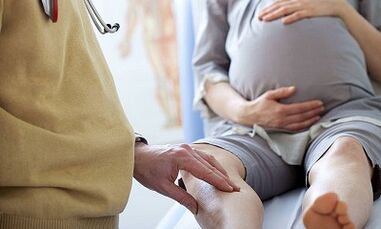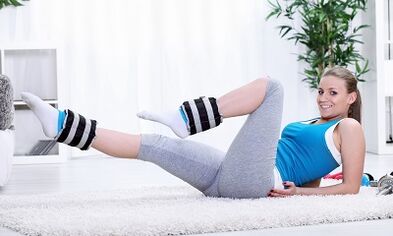
Varicose veins are a fairly common pathological disease characterized by an increase in the diameter of the lumen, thinning of the venous walls and the appearance of “nodules”.
Translated from ancient Greek, “varicose veins” means “flatulence”.Theoretically, such a disease can occur on any part of the body, but the most common lesion is the legs.
The core of the problem
Veins in the body play a very important role as they represent a network of branching reservoirs that transport blood from tissues to the heart muscle.In the lower extremities, this network manifests itself in the form of deep and superficial veins, which are connected to each other by an emergency blood drainage system.
As a rule, the focus is on the deep veins, which makes them appear noticeably stronger and more voluminous.And about 15% of the total amount of work remains on the surface.
The heart is a “pump” that pushes blood through the veins.Some blood flows through the veins against gravity (when walking, moving, or squatting).When the muscles are relaxed (while standing), the blood flows downward under the influence of the same gravity.But not everything is that simple;Valves on the walls of the vessels do not let it back.
In cases where the valves are “broken,” the veins are dilated and inflamed and can no longer maintain blood flow.This process causes the veins to swell and bulge.Disturbed blood supply becomes the cause of varicose veins on the legs.
Causes of varicose veins
There are many reasons for this:
- Varicose veins can certainly be hereditary, which means that there is a congenital weakness of the vessel walls.
- The appearance of varicose veins may be related to a person's life activity and immunity.
One thing is certain: the disease doesn't just happen; something has to trigger it.
Sedentary work causes blood to congest in the veins or pelvis, which subsequently manifests itself in health problems.Varicose veins arise from a sedentary lifestyle, so there are no obstacles to their appearance even when working standing.
It is not for nothing that this disease is primarily referred to as an occupational disease of salespeople and hairdressers.
The obvious provocateurs also include:
- overweight (obesity),
- frequent lifting of weights,
- Leg injuries.
Another factor is increased intra-abdominal pressure.The size of the veins is constantly changing, when you breathe in, the veins narrow, and when you breathe out, on the contrary, they expand.When a person pushes hard, the veins become heavily stressed and begin to expand under the pressure created.
Of course, this doesn't mean that absolutely everyone is at risk, but chronic constipation and coughing can cause varicose veins.
Varicose veins during pregnancy

Varicose veins are very common in pregnant women.The ever-expanding uterus puts involuntary pressure on the veins extending from the legs.In this case, nature protected women from serious consequences and provided the body during pregnancy with a sufficient amount of sex hormones that make the walls of blood vessels plastic and pliable.As a rule, the disease is reversible;After birth, the veins return to their previous state.
Prevention methods
Absolutely any disease is much easier to prevent than to treat, and varicose veins are no exception.Let's look at the main preventive measures:
- Forget tight and uncomfortable shoes.Women should remember that “everyday” heels should not be higher than five centimeters.In the evening, give your feet a massage and a cool bath, then raise them higher and lie in this position for 15 minutes.
- Wear loose clothing without tight elastic bands or belts.
- If possible, walk barefoot on pebbles.Treat yourself to such therapy at least during your vacation.
- Control your diet.Avoid or at least reduce the consumption of spicy, salty and smoked foods.The same applies to alcohol.
- Exercise is an excellent way to prevent varicose veins.An exception may be the initial stage of the disease.When you notice the first signs and symptoms, the stress should be low and be sure to consult a doctor before starting training.
- If you have a sedentary job, try to get up and walk around the room as often as possible.Do basic exercises, jump at least a little.Do not cross your legs when sitting, this will damage blood circulation.
- Don't overdo it with baths, saunas and whirlpools.After “hot” procedures, be sure to rinse with cold water.
Stages of development of varicose veins
- First stage.There is no pain or discomfort, only cosmetic defects are observed.A branched vein pattern appears on the legs, “stars” and “networks” appear.In the evening my legs swell a lot.
- Second stage.There is significant swelling in the ankle area and a strong feeling of heaviness in the legs.Cramps, numbness, tingling and tingling may occur in the evening.
- Third stage.Constantly severe swelling of the legs, compactions form on the skin, pigment changes, itching and dermatitis occur in places.
- Fourth stage.Trophic ulcers appear on the skin of the legs.
What measures should be taken in the initial phase?

Varicose veins of the lower extremities respond well to treatment when in their infancy;It is quite possible that a competent “fight” will stop its development.
First, follow all the preventive measures described above.If necessary, check your wardrobe, remove all “harmful” things and do the same with shoes.Treat your feet to a contrast shower, walk barefoot more and pay attention to a balanced diet.
Secondly, at the first symptoms, buy compression clothing, this can be tights or stockings.Their principle of action is to distribute pressure along the legs in such a way that blood circulation is normalized and symptoms are significantly reduced.
For consultations, you need to visit not only a phlebologist, but also a gynecologist (for women) and an orthopedist.It is likely that hormonal contraceptives or flat feet can lead to circulatory problems.
Prevention of varicose veins during pregnancy
Almost every woman struggles with swelling in the legs and poor circulation during pregnancy.The enlarged uterus constantly puts pressure on the inferior vena cava, preventing it from functioning normally.
But as mentioned above, varicose veins in this case are reversible;The main thing is to take the necessary preventive measures in a timely manner.
- Buy comfortable orthopedic shoes in which your feet will not get tired while walking.
- Take daily walks.Do not sit or stand for long periods of time.To prevent venous stagnation, place your feet on a hill when resting.
- To prevent swelling, wear compression clothing.
- Light physical exercises that only use the legs are a good help.The simplest movements of the feet in different directions are enough.
- Vitamin C is very good at preventing varicose veins.It has many beneficial properties that give elasticity to the veins while reducing the risk of many diseases.
Treatment of varicose veins
Complete relief of the disease is possible only through surgery.Medication and physical exercise are used as aids.
Phlebectomy
Operations can either be surgical in nature or use the latest technologies.One of the first methods is phlebectomy, during which varicose veins are removed.
Laser
In the second group there is laser coagulation;there are no cuts;Thermal radiation is applied to the problem area of the body.
Sclerotherapy
Another way to get rid of varicose veins is sclerotherapy.Using a thin needle, a special solution is injected into the damaged vein, which sticks the vessel walls together and then dissolves them.
However, no matter how much doctors wish, they are simply unable to eliminate the main cause of varicose veins - the weakness of the blood vessel walls.Only you have the power to prevent the disease through preventive measures.
Special exercises

Below we list a number of physical exercises that do not take much time, but the effect of which will be remarkable.You can make them at home.
- Exercise 1.Lie on the floor, lift your legs until they form a 90° angle to the floor and begin moving your toes “from you to yourself.”Repeat 10 times.
- Exercise 2.In a lying position, raise your legs and “draw” circles with your feet, ten times in each direction.
- Exercise 3.The well-known “birch” has a good effect.From the lying position, lift your legs and pelvis and place the latter on your hands.Hold this position for a few seconds.Repeat 4 times.
- Tip:Take some time to stretch.Firstly, your body always remains flexible and secondly, this pushes the blood out of the veins.
- Exercise 4.Lie on the floor with your feet together and your knees pointing in different directions.Grab your feet and pull them toward you.Stay in this position for a while.Repeat the exercise 4 times.
- Exercise 5.Lie on your left side and lean on your elbow, grab your right foot with your right hand.Make several springing movements with your hips back (try to reach your heel to your buttocks) and hold this position for 10 seconds.Do similar manipulations with the left side.
Anoint
The purpose of drugs in the treatment of varicose veins is to give the veins elasticity and a normal condition.A specialist will recommend the drug necessary for complex treatment.
An anticoagulant cream can have a good preventative effect.The latter's task is to relieve pain in the affected areas and strengthen the blood vessels.Cream preparations for varicose veins often contain a number of vitamins: C, B5 and B1, which noticeably shortens the regeneration time.
Tablets commonly used in treatment are:
- improve vascular tone;
- relieve the inflammatory process;
- accelerate blood and lymph flow;
- Eliminate microcirculation disorders.
Tablet drugs are divided into several groups: corticosteroids, phlebotonics, antithrombotics and non-steroidal analgesics.
Folk remedies

The conservative method of treatment is effective in the first stage of varicose veins, when a person feels a feeling of heaviness in the legs and notices a network of veins on the skin.The sooner action is taken to resolve the problem, the faster and more accurate the results will be.Below you will find some simple but effective recipes.
Garlic compress
A paste is made from grated garlic and butter in a 1:2 ratio, which is then applied to the affected areas and secured with paper and a bandage.The duration of exposure is overnight;Rinse your foot with warm water in the morning.
chestnut
Chestnut tincture for internal use.Fifty grams of dry product pour 500 ml of alcohol.The resulting product must be infused and filtered for 14 days.Take three times daily before meals with water.
Ointment based on Kalanchoe
A liter jar must be half filled with leaves and the rest must be filled with 70% alcohol.The resulting tincture should be kept in a dark place for two weeks, but shaken daily.The prepared ointment is rubbed into the damaged areas every day.
Love yourself and be healthy!



















